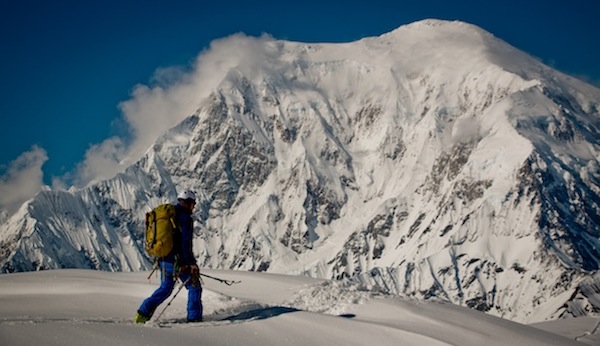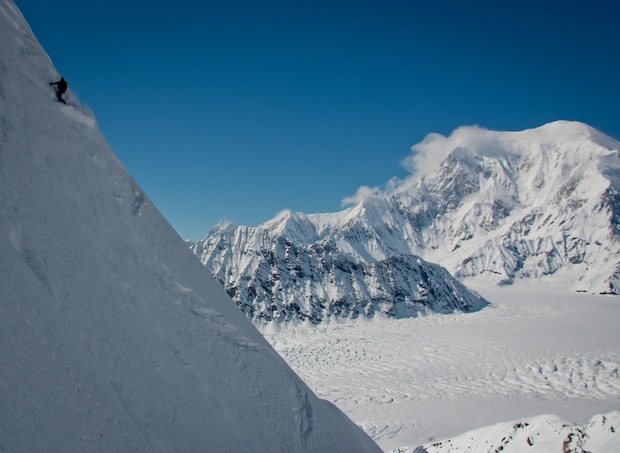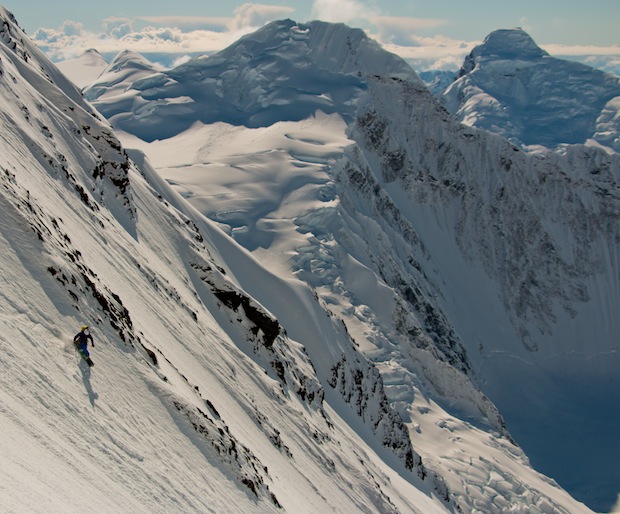 Aaron Diamond splitboarding in the Alaska Range. Anton Sponar photo.
Aaron Diamond splitboarding in the Alaska Range. Anton Sponar photo.
Exum Mountain Guide Aaron Diamond has committed nearly a decade to splitboarding and backcountry exploration, including several first descents on a snowboard—and he’s only 25 years old. In 2014, Diamond and three fellow skiers made history with a triple-threat FKT tagging the three tallest peaks in the Alaska Range: Hunter, Foraker, and Denali. In the course of 31 days, the quad winter camped, climbed and skied 67,000 vertical feet. Until then, only one person had skied all three beasts—Andrew McLean—though, not in a single expedition. Hunter and Foraker and never seen a snowboard descent.
True, the weather window was unrealistically good—Diamond and crew only spent three days caught in a tent due to horrific weather for that entire month—to which, Diamond’s humble demeanor would sum up the expedition’s success as lucky. Luck may have played a role, but a 100-percent self-supported backcountry expedition through one of the world’s burliest mountain settings demands much more skill than luck.
For five years straight, Diamond worked winter guiding gigs back-to-back between his home in Wyoming and Ski Arpa, in the Chilean Andes. He teaches Avalanche Level I-II courses for the American Avalanche Institute, and guides rock climbing trips in the summer throughout the Tetons and Wind River Range.
Between expeditions, we caught up with Diamond on how he became a guide, the advantages of splitboarding, advice for the backcountry novice, and how fear has helped to change him for the better.
 Diamond studying the terrain. Jordan White photo.
Diamond studying the terrain. Jordan White photo.
MT: How were you introduced to snowboarding?
AD: I grew up skiing in the Pocono Mountains. I would spend a lot of time with my father at the hill when I was growing up. He was a volunteer ski patrol member on the weekends. When I turned sixteen, I joined the ski patrol as a volunteer, as well. That’s when I took my first avalanche class.
MT: Do you still remember your first backcountry experience?
AD: When I was in middle school, my father introduced me to backcountry skiing at Tuckerman Ravine, the classic New England spring destination on Mt. Washington. We skied some other areas of the mountain, as well. My dad didn’t really ski backcountry that much, so as soon as I had a license I spent a bunch of time up there with a couple of good friends. We would sleep in the back of our cars.
MT: Classic! So, not much has changed, then?
AD: Haha—unfortunately, not much has changed.
MT: Did you always know that you wanted to be a guide?
AD: I’ve wanted to be a snowboard guide since middle school, but the reasoning has changed.
At first, I knew I wanted to ride a lot and didn’t think I could be good enough to be a professional snowboarder. Once I started guiding, I realized that the experience was more about client reward, and the reward that I get from having those people have a good time, both in their comfort level and slightly out of their comfort level, by them not knowing that they could do something or being able to do something that they had dreamed about.
 Diamond snowboarding off of Sultana Ridge on Mount Foraker in the Alaska Range. Jordan White photo.
Diamond snowboarding off of Sultana Ridge on Mount Foraker in the Alaska Range. Jordan White photo.
MT: You didn’t move to the Tetons until 2010—what’d you do that first winter out of high school?
AD: I moved to B.C. to do an internship outside of Revelstoke at a cat skiing lodge. I worked as a tail guide and lodge manager taking care of things like cooking and any mechanics. Afterwards, I decided to move to Jackson, because I’d vacationed there and a good buddy I’d skied with in high school was living there. It seemed like a no brainer.
That first winter broke 800 inches and I was hooked. That was enough.
MT: Did your career kickoff right away when you moved to Jackson?
AD: I tried really hard to become a guide right away, but no one would hire me. For the first two or three winters, I would go back to Pennsylvania to live at home, work putting up party tents and save enough money to be unemployed for the winter. At the end of October I would pack everything up and drive back across the country to Jackson. I would ski everyday. I ate enough Top Ramen to last a lifetime.
MT: Ah, the glory days! What happened three seasons later?
AD: I got hired to teach avalanche classes for the American Avalanche Institute. That was my first break into Jackson guiding and avalanche world. Shortly thereafter, Exum had a need for an avalanche instructor, they called AI, and AI referred me.
 Diamond riding past gnarly, gorgeous terrain in the Alaska Range. Anton Sponar photo.
Diamond riding past gnarly, gorgeous terrain in the Alaska Range. Anton Sponar photo.
MT: After working for several years with AAI and Exum, how has your perspective of backcountry exploration changed?
AD: As a teacher and guide, you’re exposed to so many different students and various ways of thinking, so I’ve learned quite a bit by teaching avalanche classes, both from my fellow instructors and from students. I’m biased, but I have the privilege of working with some of the best avalanche professionals and guides in the country, and being immersed in that culture is quite good—my risk tolerance has dropped as a recreationalist.
Now, it’s difficult for me to turn off the guide brain. I look at things a differently from an objective hazard perspective, as well as the situations that are really low probability and high consequence—which I used to be more willing or ignorant toward regarding the associated risk. I’ve come to terms with what I don’t know and can’t know, like the spatial variability of the snowpack, especially in higher alpine terrain. In terms of low probability-high consequence issues, I got away with those situations more than I would like to admit, and I’ve toned back. I am not as willing to take as many rolls of the dice.
MT: Do you have a morning routine before you head outside to guide, teach and tour?
AD: I check the weather and avalanche conditions. I review my notes from previous days, and—especially if I’m unfamiliar with the area—I try to leave the house as informed as I can be, whether I’m leaving for work or going skiing with buddies. The morning is about getting as much information as I can before I walk into it.
 Diamond and Alex Kretchmann ascending the East Face of Buck Mountain in the Tetons. Zahan Billimoria photo.
Diamond and Alex Kretchmann ascending the East Face of Buck Mountain in the Tetons. Zahan Billimoria photo.
MT: What kind of notes do you take in the field or beforehand?
AD: In the morning, I mostly take weather notes. Throughout the day, I write down details about the snow, what I see regarding avalanche conditions, what the weather is doing, and snow pit results. If I’m working, I write down clients’ medical history, goals, family members, and any other important info about them. Taking down notes helps me in a number of ways.
MT: Definitely. A notepad seems like a great tool: How does writing down all of that info help you?
AD: From a snow perspective, taking notes helps with my memory in a broad sense. It helps me remember where I have seen objects on the surface snow, so that as things get buried I know what’s beneath the top layer. Notes about the weather help me to track what’s going on with the snow layers as they build and change. As far as notes related to the map and terrain, those can tell me if I’m on time, running late or running early—which helps me stay on schedule.
Notes also help me to remember things that would I would have trouble remembering in a complex dynamic situation.
 Sharing the stoke on Buck Mountain in the Tetons: Diamond and Alex Kretchmann. Zahan Billimoria photo.
Sharing the stoke on Buck Mountain in the Tetons: Diamond and Alex Kretchmann. Zahan Billimoria photo.
MT: Have you been in any hairy scenarios?
AD: On Denali last year I had a client that developed a bad episode of high-altitude pulmonary edema. He ended up being evacuated by helicopter at High Camp at 17,000 feet. We spent quite a bit of time with him in an inflatable pressure bag to simulate lower altitude and higher oxygen.
While skiing, I’ve also had friends take unroped crevasse falls. Fortunately, they ended up fine, but those situations were quite scary at the time. One friend took a 50-foot crevasse fall and he managed to come out with only a couple of bruises.
I’ve been mostly really lucky.
MT: Do you have fears regarding your work, and how do you manage those realities?
AD: For sure: There is risk associated with most parts of my job. I think that to not be a little scared of that risk would probably be really unsafe. To mitigate fears, I have a good support system from mentors in and out of both companies. And, I think that I am able to both acknowledge that fear and mitigate it by being confident in myself to make good decisions when I’m working and when I’m recreating.
 Diamond carving into his toe edge on Mount Foraker's Sultana Ridge in the Alaska Range. Anton Sponar photo.
Diamond carving into his toe edge on Mount Foraker's Sultana Ridge in the Alaska Range. Anton Sponar photo.
MT: Are there any disadvantages—or advantages—to backcountry travel on a splitboard versus on traditional skis?
AD: To some extent, you’re certainly less mobile as a splitboarder with both of your feet attached to the board. In reality, I ride with 85 percent skiers; and there are also upsides to snowboarding in the backcountry.
Snowboarders have an easier time in variable snow conditions. If you take a similarly skilled skier and snowboarder and put them on bad, breakable crust, the snowboarder is less prone to have issues and skis may end of doing the splits. A snowboard is a more powerful downhill tool in a fall line sense.
Snowboarders also have the benefit of being in a good self-arrest position while they are on their toe side—the trade off is a really horrible self-arrest position on the heel side. (The ability to self-arrest is also not crucial but it is handy.) Also, the fact that snowboards are little bit shorter than skis means that they tend to fit in weird places than skies can’t fit.
So, there is give and take between the two options.
MT: How would you compare snowboarding to splitboarding?
AD: Being a good splitboarder as opposed to being a good snowboarder requires different skills; there is a learning curve from one to the other.
As a splitboarder, you don’t need to be able to ski a 50-degree couloir, but you need to be able to cover undulating terrain—including flat and rolling moderate slopes—and being able to ski downhill with your splitboard in half is crucial in part to safety as well as from a headache point of view and ease of use.
Also, if you’re in the backcountry and something happens—say, if someone is caught in an avalanche—in which you need to go quickly downhill, you need to be able to do a timely transition from ski to board mode. If it takes 10 minutes to do a transition then you have hosed yourself.
 Diamond snowboarding West Face of Thunder Mountain in the Alaska Range. Anton Sponar photo.
Diamond snowboarding West Face of Thunder Mountain in the Alaska Range. Anton Sponar photo.
MT: What advice do you have for a resort rider or skier who wants to start touring in the backcountry?
AD: My first piece of advice is to take an avalanche class. If you can, take it with your friends. Go into the course with not only an open mind but also a serious demeanor and the understanding that when you go out into the backcountry, there are real consequences. There are real rewards, as well, but your education should be taken seriously.
After taking an Avalanche Level 1 course, progress is about practice, recognizing that you’re still really new at backcountry, and taking really small steps from the terrain choices to going out with your friends. It’s a slow process and it’s important to take your time with it.
MT: Who would you recommend to sign up for the Avalanche Level II course?
AD: The people who typical take the Level II course are aspiring professionals who want to be guides or forecasters. It doesn’t seem that as many recreationalists are taking the Level II course, but I think that the course should be more of a prerequisite than people give it credit for—especially with glorified terrain like that around the Tetons. A lot of people step into really complex terrain. General experience in the backcountry is beneficial, but the formal learning experience that people have in a Level II course provides crucial information regarding more complex and high consequence terrain.
MT: What goals do you have ahead?
AD: Career-wise, I am working toward an international guide certification. For trips, I would like to ride another route this spring off of Mount Foraker. I would also like to ski in the Himalaya or Karakoram Mountains, hopefully this fall. Skiing over there and in such high mountains is a gamble as far as snow and weather. If you go expecting to ski there’s a decent chance you’ll be disappointed! I’ll plan an expedition with the goal of skiing and then play it by ear.
 Diamond taking steep lines in the Alaska Range. Anton Sponar photo.
Diamond taking steep lines in the Alaska Range. Anton Sponar photo.
For further splitboard info and guidance from Aaron Diamond, visit www.aarondiamondbackcountry.com.


